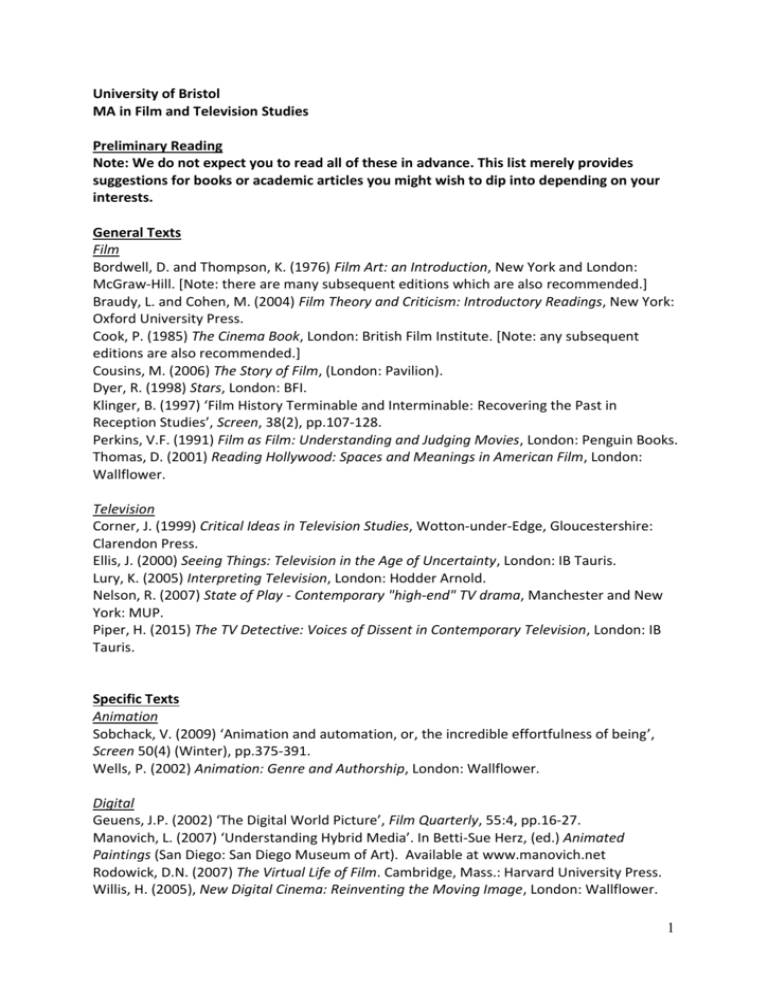Reading list (Office document, 24kB)
advertisement

University of Bristol MA in Film and Television Studies Preliminary Reading Note: We do not expect you to read all of these in advance. This list merely provides suggestions for books or academic articles you might wish to dip into depending on your interests. General Texts Film Bordwell, D. and Thompson, K. (1976) Film Art: an Introduction, New York and London: McGraw-Hill. [Note: there are many subsequent editions which are also recommended.] Braudy, L. and Cohen, M. (2004) Film Theory and Criticism: Introductory Readings, New York: Oxford University Press. Cook, P. (1985) The Cinema Book, London: British Film Institute. [Note: any subsequent editions are also recommended.] Cousins, M. (2006) The Story of Film, (London: Pavilion). Dyer, R. (1998) Stars, London: BFI. Klinger, B. (1997) ‘Film History Terminable and Interminable: Recovering the Past in Reception Studies’, Screen, 38(2), pp.107-128. Perkins, V.F. (1991) Film as Film: Understanding and Judging Movies, London: Penguin Books. Thomas, D. (2001) Reading Hollywood: Spaces and Meanings in American Film, London: Wallflower. Television Corner, J. (1999) Critical Ideas in Television Studies, Wotton-under-Edge, Gloucestershire: Clarendon Press. Ellis, J. (2000) Seeing Things: Television in the Age of Uncertainty, London: IB Tauris. Lury, K. (2005) Interpreting Television, London: Hodder Arnold. Nelson, R. (2007) State of Play - Contemporary "high-end" TV drama, Manchester and New York: MUP. Piper, H. (2015) The TV Detective: Voices of Dissent in Contemporary Television, London: IB Tauris. Specific Texts Animation Sobchack, V. (2009) ‘Animation and automation, or, the incredible effortfulness of being’, Screen 50(4) (Winter), pp.375-391. Wells, P. (2002) Animation: Genre and Authorship, London: Wallflower. Digital Geuens, J.P. (2002) ‘The Digital World Picture’, Film Quarterly, 55:4, pp.16-27. Manovich, L. (2007) ‘Understanding Hybrid Media’. In Betti-Sue Herz, (ed.) Animated Paintings (San Diego: San Diego Museum of Art). Available at www.manovich.net Rodowick, D.N. (2007) The Virtual Life of Film. Cambridge, Mass.: Harvard University Press. Willis, H. (2005), New Digital Cinema: Reinventing the Moving Image, London: Wallflower. 1 Documentary Nichols, B. (1991) Representing Reality: Issues and Concepts in Documentary, Bloomington: Indiana University Press. Nichols, B. (2010 [2001]) ‘How Can We Define Documentary Film?’ in Introduction to Documentary, Bloomington, Indianapolis: Indiana University Press, 2nd edition, pp.1-41. Renov. M. (1993) (ed.) Theorizing Documentary, New York: Routledge. Colour, Editing, Lighting, Mise-en-scene, Performance, Sound Alton, J. (1995 [1949]), Painting with Light, Berkeley: University of California Press. Baxter, P. (1975) ‘On the History and Ideology of Film Lighting’, Screen, 16:3, pp. 83-106. Brown, S., Street, S., and Watkins, L. (eds) (2012) Color and the Moving Image: History, Theory, Aesthetics, Archive, Oxon and New York: Routledge. Chion, M. (1994) Audio-Vision: Sound on Screen, New York: Columbia University Press. Crittenden, Roger (ed.) (2006) Fine Cuts: the art of European film editing, Oxford: Focal Press. Gibbs, J. (2002) Mise-en-Scene: Film Style and Interpretation, London: Wallflower. Klevan, A. (2005) Film Performance: From Achievement to Appreciation, London: Wallflower. Naremore, J. (1988) Acting in the Cinema, Berkeley and Los Angeles: University of California Press. Orpen, V. (2003) Film Editing: the art of the expressive, London: Wallflower Press. Reisz, K. and G. Millar (1996 [1953]) The Technique of Film Editing, Oxford, Boston: Focal Press. Street, S. (2012) Colour Films in Britain: The Negotiation of Innovation 1900-1955, London: Palgrave MacMillan. Turnock, J. (2009) 'Before Industrial Light and Magic: the independent Hollywood special effects business, 1968-75', New Review of Film and Television Studies, 7(2), pp.133-56. Weis, E. & Belton, J. (eds) (1985) Film Sound: Theory and Practice, New York: Columbia University Press. National/Transnational Cinemas Ezra, E., & Rowden, T. (eds.). (2006) ‘General Introduction: What is Transnational cinema’, in Transnational cinema: the film reader, US: Taylor & Francis, pp.1-12. Higbee, W. and Song, Hwee Lim. (2010) ‘Concepts of transnational cinema: towards a critical transnationalism in film studies’, Transnational Cinemas, 1(1), pp.7-21. Solanas, F. and Getino,O. ‘Towards a Third Cinema: Notes and Experiences for the Development of a Cinema of Liberation in the Third World’, in Chanan, M. (ed) (1985), Twenty-Five Years of the New Latin American Cinema, London: BFI and Channel 4, pp.17-27 [first published in 1969]. Any books in the Routledge National Cinema series depending on your interests. 2







